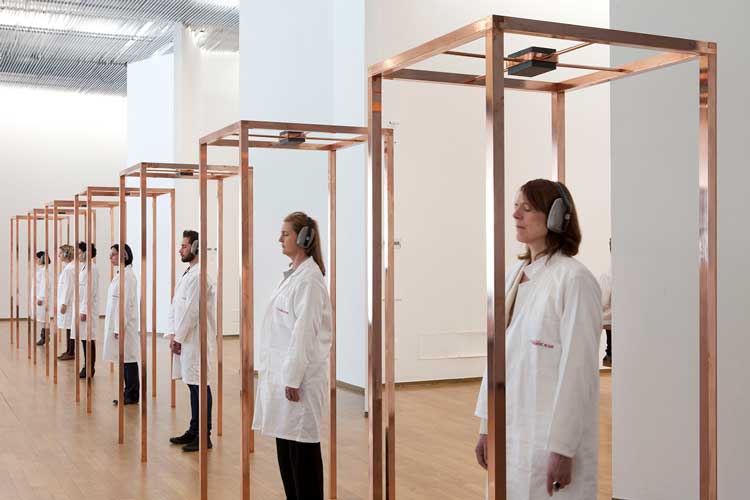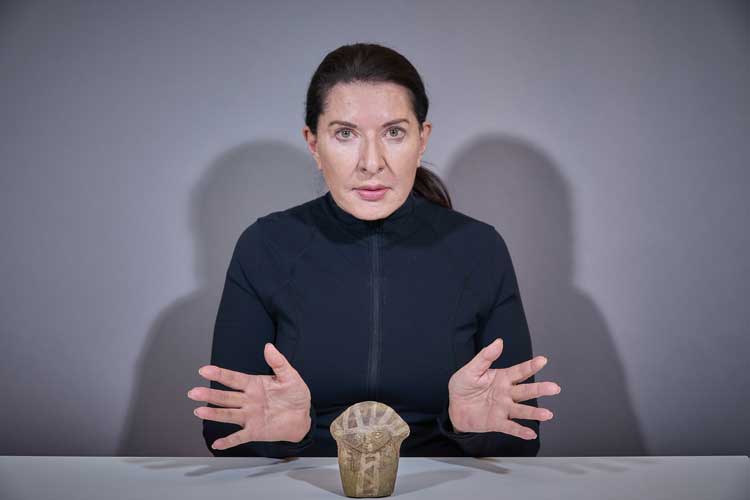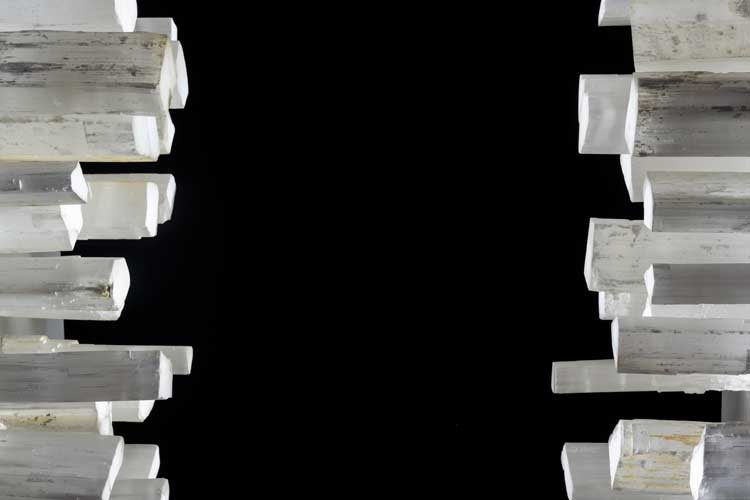
Marina Abramović, Presence and Absence, 2022. Courtesy of the artist and the Pitt Rivers Museum, University of Oxford. Photo: Tim Hand.
Modern Art Oxford
24 September 2022 – 5 March 2023
and
Marina Abramović @ Pitt Rivers Museum
Pitt Rivers Museum, Oxford
24 September 2022 – 2 April 2023
by ANNA McNAY
I am either the absolute best or the absolute worst person to be reviewing Marina Abramović’s new duo of exhibitions in Oxford. Although Gates and Portals, at Modern Art Oxford, is being billed as a “site-specific performance-based work”, really there is no element of performance – at least not in the conventional sense. Instead, Abramović is keen to explain, the visitor becomes the performer. At the press launch of the exhibition, the seasoned performance artist (b1946, Belgrade), who has made a successful and groundbreaking career out of the concepts of presence and absence, emphasised her basic belief that “performance without public doesn’t exist”, and that, in this instance, she “want[s] to give more than just participation, [she] want[s] to give ‘real experience’”. In a defence to the question of whether she is actually doing anything – one that she says she is asked over and over again – she states that, after The Artist is Present (Museum of Modern Art, New York, 2010), she realised she had become an obstacle to her own work. While, at her takeover of the Serpentine Gallery in London four years later, she introduced the idea of “facilitators” – gallery assistants who have been trained in her methodology at the Marina Abramović Institute (MAI, in Hudson, US, since 2012) – she was, nevertheless, still present for the full 512-hour duration. Now, however, it is time for the public to “make the journey” and, alongside facilitators from the MAI, gallery assistants from Modern Art Oxford also underwent three days of intensive training, including counting grains of rice and opening and closing a door silently, both for hours at a time.

Marina Abramović, Time Energizer, from the series Transitory Objects, 2000/2012. Copyright Marina Abramović. Image courtesy of the Marina
Abramović Archives. Photo: Fabrizio Vatieri.
What exactly is the “journey” all about? In a nutshell: sensory deprivation, with a little bit of sensory overload thrown into the mix. First things first: visitors are asked to remove their watches and leave them, mobile phones, and any other potential distractions, in a locker at the museum entrance. This is for what Abramović terms “an electronic detox”, an idea now prevalent, but which she claims to have invented. Then, accompanied by a facilitator, the visitor enters the first gallery and is asked to don a set of noise-cancelling headphones. With shut eyes, you are then led to stand beneath a so-called Time Energizer, from Abramović’s series of Transitory Objects (2000/2012) – essentially a copper frame, with a strong magnet above your head. With the force fields being disrupted by the magnet, and your own sense of gravity and equilibrium thrown by the absence of sound, you might already begin to feel a little disoriented. This is, according to the artist, the “physical transition”. This structure, for Abramović, is the gate, leading the visitor from one world to another and conditioning the body to be receptive to what comes.

Marina Abramović, Presence and Absence, 2022. Courtesy of the artist and the Pitt Rivers Museum, University of Oxford. Photo: Tim Hand.
After what, to many, may seem a long time, you are led to face a white wall. Things are then cranked up a gear, as a blindfold is added to the headphones and you have to trust the facilitator not just to lead you, but to guide you into a chair. After this, there is a time out, or interval, where the blindfold and headphones are removed, and you can spend as much or as little time as you want watching a film of the artist, Presence and Absence (2022), holding objects from the global collections of the Pitt Rivers Museum, where she spent a month on a residency last summer. The 13 objects – which Abramović says she did not choose; rather they chose her – are all associated with magic, rites of passage, sites of transition and transformative states of consciousness. I will come back to this later, for it seems an unnecessary excursus at this point in my writing, just as I remain uncertain why it has been placed midway through the “electronic detox”, since moving image, even if it is scarcely moving, is something of a digital onslaught amid the time out from the modern world.
Once you choose to move on from the film (which can also be seen in the museum cafe and at the Pitt Rivers Museum), you go, once again with the headphones, into the final large gallery space, entering, first, through Portal (2022), a door frame with large white selenite shards projecting inwards, a little like stalactites. They are lit with an intense white light and are mesmerising and beautiful. It begins to feel as if you might be emitting white light yourself, actualising what Abramović sees as the “spiritual transformation”. Finally, you are led to a “bed”, or marked-out area of floor, where you are left to lie in the silence, again for as long as you want.

Marina Abramović, Portal, 2022. © Oak Taylor-Smith for Factum Arte and Marina Abramović. Image courtesy of the Marina Abramović Archives.
Why am I the right person to write this review? Because I am a regular practitioner of yoga, mindfulness and grounding techniques, and because I have spent the past eight months learning about sensory modulation for anxiety management, as well as having my own sensory profile done. Certainly, this awareness made it easy for me to quickly tune in to my body and its response to the elimination of sound, sight and all means of telling the time. While the common answer to how many senses a human being has is five – sight, sound, smell, taste and touch – there are actually eight, with the further three being proprioception (knowing where the body is in space and the ability to sense its location, movements and actions), interoception (understanding your body’s internal signals) and vestibular (relating to balance and spatial orientation). As is usual for me, when I attempt any form of mindfulness, the first stages of this facilitator-led “journey” weren’t a particularly pleasant experience, as my heart rate immediately shot up (observation number one for interoception), as did the speed and number of my thoughts and the volume of the myriad competing voices in my mind. My sense of proprioception was also completely disrupted, especially by being led from one room to another without the ability to see and with no prior knowledge of the layout of the exhibition, and being seated by someone else required a good deal of trust and, accordingly, a fair share of anxiety. Perhaps less directly, my vestibular sense was unnervingly disrupted, which led me to feel as if I were swaying (and I might well have been), able to sense down to my diaphragm, but then nothing – an emptiness and disconnection – until my feet. There was a strong feeling of everything – blood, thoughts, weight (or should I more correctly say mass, since my weight – the force exerted on my body due to the pull of gravity – was what was being disrupted as a result) – gushing down to my toes, unsteadying me, and making me grateful when the facilitator came to move me on.
The white light from Portal, as I have said, was alluring, inducing something of a trance. Its effulgence seemed all-encompassing, irradiating body, mind and spirit, as if, those with a religious bent might say, resembling the descent of the Holy Spirit on to the disciples at Pentecost. And the “bed”, well, I could easily have stayed lying there for hours. Its cool surface, in a room of warm air, was soothing and revivifying – offering the period of integration for mind, body and spirit provided by savasana at the end of a yoga practice. Press colleagues, however, reported struggling to find a comfortable position and not coming to the stillness sought after in what is often also termed “corpse pose”. This is perhaps a further indication of my suitability for reviewing this “exhibition”. The one thing we all agreed on, however, was how rapidly time had passed, and how we were shocked to look at our watches when retrieved from the lockers.
Abramović says: “It’s very rare to experience silence and to stay in one place. It’s not going to change your life, but this is an attempt to do something different … In a nutshell, you are asked to do things that you would usually never do, and this gives rise to different emotions. There is impatience, anger, and the enjoyment of being bored. Then you pass through all of this to get that sense of being truly present, when time doesn’t exist, and everything is gone.”
So why was I the worst person to review the exhibition? Perhaps because I have just spent six months in hospital and am therefore very used to staying in one place, where time passes incredibly slowly (waiting for each minute of each day to go by) and more quickly than imaginable (how did it get to six months?!), the whole experience was rather underwhelming, and it felt more as if I had just taken part in a yoga nidra session than undergone any profound journey. To turn to the words of a prayer written by John Donne (1572-1631), some of which was quoted at the Queen’s state funeral at Westminster Abbey by the precentor Rev Mark Birch: “Bring us, O Lord God, at our last awakening into the house and gate of heaven, to enter into that gate and dwell in that house, where there shall be no darkness nor dazzling, but one equal light; no noise nor silence, but one equal music; no fears nor hopes, but one equal possession; no ends nor beginnings, but one equal eternity: in the habitations of thy majesty and glory, world without end.” Does this not suggest that neither sensory deprivation nor sensory overload brings us closer to passing through that gate (or portal) and experiencing spiritual transformation? Instead, there will be “one equal light” and “one equal music”.
Staying with religious analogies for a moment longer, it seems just a little contrary that, on the one hand, Abramović rails against having become a celebrity, while, on the other, she repeatedly represents herself as a god-like figure. There is something scarily cultish and indoctrinating about the MAI (and even her brief, albeit intense, training of the Oxford team), and, in Presence and Absence, she positions herself in the centre of the screen, with a double shadow on the wall behind her, strongly evoking the Holy Trinity – Father, Son and Holy Ghost. Abramović, however, is more interested in Tibetan Buddhism than Christianity, and thus she is said to be very happy that the film is being screened, at the Pitt Rivers Museum, in a space where a Mongolian temple is usually on display. The fact that it is facing – and therefore playing to – a statue of Buddha is also auspicious. Making clear the common thread between this exhibition and the one at Modern Art Oxford, Abramović says of the film, in which she interacts with her 13 chosen objects, before they disappear, leaving her caressing thin air: “Emptiness is so important. I believe that when you sit in one position for a long period of time and then go away, the energy is still there. Energy stays in the space.” Unfortunately, the space in which to view the film at Pitt Rivers Museum is fairly small, and as there is no option to sit, I think it unlikely many visitors will hang about watching it for very long – just as they won’t at Modern Art Oxford.
Of her time spent at the Pitt Rivers Museum, Abramović says it blew her mind. The 13 objects – which were selected from many hundreds in the global collections – embody mental, physical and spiritual experience from different cultures. For example, when handling the Kamyana Baba – a 500kg sandstone figure of a woman from the southern steppes in what is now Dnipropetrovsk province in Ukraine, typically found on top of burial mounds and possibly representing a local goddess, revered for her powers to decide human fate – Abramović felt the energy, and the pain, of the people who had created it. Other artefacts include a mid-19th-century silvered glass bottle said to contain a witch; a rowan tree cross used as an amulet to protect against witchcraft; a smooth rounded pebble from Australia, used as a love charm; and a votive object (tsa-tsa) in the form of an oval-shaped painted clay plaque representing Palden Lhamo, the wrathful goddess of Tibetan Buddhism, identifiable by the eyes on the backside of her horse, and manifesting her anger in the sea of menstrual blood through which she rides and the weapons she carries in her four hands. This latter object seems especially pertinent to the theme of Abramović’s exhibitions (not just for its cultural provenance). It is an age-old Tibetan belief – pre-dating Buddhism – that every person, family and country has a life-spirit bound up in the trees, lakes and mountains. If something untoward should happen to a tree, lake or mountain, the associated person, family or country will suffer death, disease or disaster. Palden Lhamo’s spirit is said to reside in Lake Lhamo Latso, along with the life-spirit of Tibet itself. Abramović’s notion, then, that something’s or someone’s energy remains, even should they no longer be present, is fortuitous for Tibet – and, indeed, for the creators and owners of the other objects as well.
Abramović’s one-month residency comprised wandering around the collections, allowing the objects to speak to her, making drawings (also on display), researching her chosen artefacts, and then filming (there is also a second short video work, The Witch Ladder (2022), being shown). Alongside the drawings and films, an information leaflet provides a map of seven of the 13 objects’ locations (in vitrines near to where the film screen stands; the remaining six objects, located upstairs, are not included, so as to keep the trail accessible), and, for visitors, taking part in this “treasure hunt” (which I overheard someone describe as a “Pokémon hunt”) certainly engenders curiosity to learn more about the artefacts (which can be done by scanning the QR codes in situ or by searching the online collection using the accession codes given in the leaflet). As to whether you can feel the objects’ energies, however – be that standing looking at them or watching the artist contemplate their absence, her hands hovering, as if over a crystal ball – I remain doubtful.
Ultimately, if there has been any journey undergone at all in these two exhibitions, it has been from the artist being present to her being absent. The Modern Art Oxford show might just as well have been called The Artist is Absent, but I don’t wonder why it wasn’t, since then it might have sounded as much of a letdown as it veritably is.